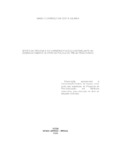Please use this identifier to cite or link to this item:
http://www.alice.cnptia.embrapa.br/alice/handle/doc/920282| Title: | Efeito da tiroxina e do hormônio folículo estimulante no desenvolvimento in vitro de folículos pré-antrais ovinos. |
| Authors: | CALIMAN, S. L. da C.  |
| Affiliation: | Sanely Lourenço da Costa Caliman. |
| Date Issued: | 2010 |
| Citation: | 2010. |
| Description: | O presente experimento foi desenvolvido a fim de se verificar o efeito da tiroxina na presença ou ausência do hormônio folículo estimulante (FSH) sobre a sobrevivência e o crescimento de folículos pré-antrais de ovinos. Fragmentos de tecido ovariano foram cultivados por 1 e 7 dias em meio essencial mínimo (?-MEM+) suplementado ou não com diferentes concentrações de tiroxina (10, 20, 50 µg/mL) na presença ou ausência de rFSH (50 ng/mL). O tecido ovariano não-cultivado (controle fresco) e os fragmentos cultivados no dia 1 e 7 nos diferentes tratamentos foram processados e analisados utilizando a técnica de histologia clássica. Quando os dias de cultivo foram comparados ao controle não-cultivado, somente no dia 1 foi verificado que os tratamentos contendo ?- MEM+, FSH, T20 e T50 mostraram percentuais de sobrevivência folicular semelhantes ao controle. Quando os tratamentos foram comparados entre si dentro de cada período de cultivo, foi observado que apenas no dia 7, o tratamento contendo T50 apresentou um percentual de folículos normais superior ao tratamento T10F. Com relação ao diâmetro folicular, não houve crescimento dos folículos em cultivo, uma vez que todos os tratamentos comportaram-se de maneira semelhante ao controle não-cultivado e ao ?- MEM+, exceto o tratamento T10. Ao se comparar os tratamentos, dentro de cada período de cultivo, foi observado que no dia 1 os tratamentos T50, T10F e T50F apresentaram diâmetro folicular superior quando comparados ao tratamento T10. Semelhante ao crescimento folicular também não houve crescimento oocitário. Para o diâmetro oocitário, no dia 1, foi verificada uma redução para os tratamentos T10 e T20F quando comparados ao não cultivado. Já no dia 7 de cultivo os tratamentos FSH, T10F e T50F reduziram o diâmetro oocitário, com a progressão do cultivo do dia 1 para o dia 7 e ainda quando comparados ao controle não-cultivado e ao ?-MEM+. Concluiu-se que altas concentrações de T4 (50 ?g/ml) proporcionaram resultados promissores no que diz respeito à sobrevivência e desenvolvimento folicular in vitro. Quanto a associação da T4 com o FSH não demonstrou resultados positivos na sobrevivência e no desenvolvimento folicular in vitro. Embora seja conhecida a atuação da tiroxina na fisiologia ovariana são necessárias mais pesquisas que verifiquem sua importância para o desenvolvimento in vitro de folículos pré-antrais ovinos. [Effects of thyroxin and follicle stimulating hormone on the in vitro development of ovine preantral follicles]. Abstract - This experiment has been developed in order to verify the thyroxine effect in the presence or absence of follicle stimulating hormone (FSH) on survival and growth of sheep preantral follicles. Fragments of ovarian tissue were grown for 1 or 7 days in a situation with a minimum essential (?-MEM +) alone or containing thyroxine (10, 20, 50 µg/mL) in the presence or absence of rFSH (50 ng/mL). The ovarian tissue non-grown (fresh control) and grown in different treatments were processed for analysis using the classical histology technique. When the days of culture were compared to the non-cultivated control, on the first day was found that the treatment with ?-MEM+, FSH, T20 and T50 showed follicular survival percentages similar to control. When the treatments have been compared between each other within the growing season was identified that only on the 7th day, the treatment containing T50 presents a percentage of normal follicles significantly superior to the treatment with T10F. Related to the follicular diameter, the follicle in culture has not grown, since all treatments have had a similar behavior when controlling non-grown and ?- MEM+, except the T10 treatment. When comparing the treatments within each growing season, it has been observed that on the first day, treatments T50, T10F and T50F have showed a follicular diameter greater when compared to T10 treatment. Similar to what happenedto follicular growth, oocitário growth has not grown either. For oocitário diameter, on the first day, there was a reduction for T10 and T20F treatments when compared to non-grown. On the 7th day of grown, FSH, T10F and T50F treatments have reduced oocitário diameter, with a progression of culture from the first day to the 7th one and even when compared to control non-grown and ?-MEM+. It was concluded that high T4 concentrations (50 g / ml) have provided promising about the survival and follicular development in vitro. The association of T4 with FSH, have not presented positive results in the survival and follicular development in vitro. Although it is known the thyroxine action on ovarian physiology, there is a need to verify its importance for the in vitro development of preantral sheep follicles. |
| Thesagro: | Ovino Reprodução animal Tiroxina |
| Keywords: | Folículos pré-antrais FSH |
| Notes: | Dissertação (Mestrado em Medicina Veterinária) - Universidade Federal de Viçosa, Viçosa, MG. Orientador: Eduardo Paulino da Costa; Co-Orientador: Laércio dos Anjos Benjamin, Co-Orientador: Jeferson Ferreira da Fonseca, Embrapa Caprinos e Ovinos (CNPC); Co-Orientador: José Domingos Guimarães. |
| Type of Material: | Teses |
| Access: | openAccess |
| Appears in Collections: | Tese/dissertação (CNPC)  |
Files in This Item:
| File | Description | Size | Format | |
|---|---|---|---|---|
| CNPC2010Efeitodatiroxina.pdf | 1.86 MB | Adobe PDF |  View/Open |









